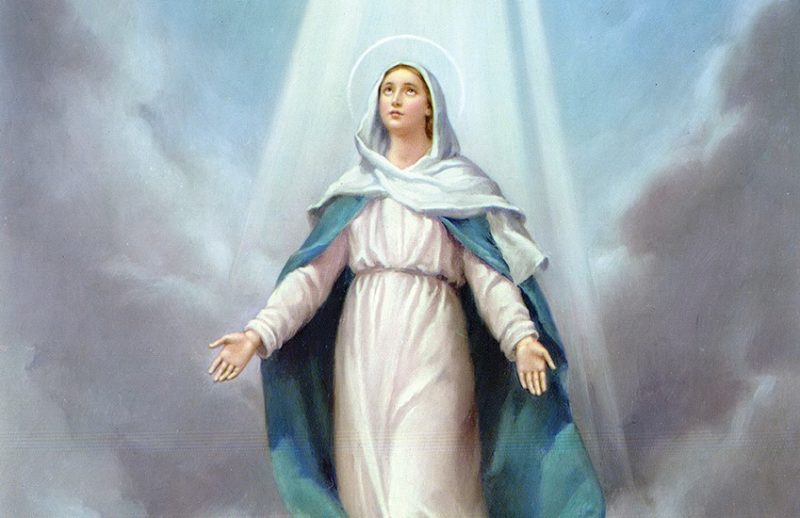The Assumption of Our Lady has been believed and celebrated since the earliest times of Christianity. Some claim that the Assumption never happened because it is not described in the Holy Scriptures, but we must remember that the Bible does not detail all of the events in Our Lady’s life or those of the Apostles. The Bible does not mention the earthy end of any of the original disciples with the exception of St. James, who died early on (cf. Acts 12:1-2). Does that mean they did not die? Of course not! So, how could the omission of the Assumption possibly refute it? It doesn’t.
The Early Church on the Assumption
In order to make it a dogma of the Faith, meaning all Catholics must believe it, Pope Pius XII dogmatically defined Mary’s Assumption into Heaven on November 1, 1950:
“… by the authority of our Lord Jesus Christ, of the Blessed Apostles Peter and Paul, and by our own authority, we pronounce, declare, and define it to be a divinely revealed dogma: that the Immaculate Mother of God, the ever Virgin Mary, having completed the course of her earthly life, was assumed body and soul into heavenly glory” (Munificentissimus Deus).
The Feast of the Assumption, however, had been celebrated for centuries before this proclamation. In fact, in Munificentissimus Deus, Pope Pius XII cited the Roman liturgy, Gallican sacramentary, and the Byzantine liturgy in support of the Assumption. The Feast of the Assumption was celebrated under various names (e.g., Commemoration, Dormition, Passing, Assumption) from at least the fifth or sixth century. Homilies concerning the Assumption go back to at least the Sixth Century.
Pope Pius XII likewise mentioned or quoted St. Anthony of Padua, St. Damascene, St. Albert the Great, St. Thomas Aquinas, St. Bonaventure, St. Robert Bellarmine, St. Alphonsus Liguori, St. Peter Canisius, and Suarez, all of whom either outright supported the Assumption or at least did not deny it. For instance, St. John Damascene (675-749) states:
“It was fitting that she, who had kept her virginity intact in childbirth, should keep her own body free from all corruption even after death. It was fitting that she, who had carried the Creator as a child at her breast, should dwell in the divine tabernacles. It was fitting that the spouse, whom the Father had taken to himself, should live in the divine mansions. It was fitting that she, who had seen her Son upon the cross and who had thereby received into her heart the sword of sorrow which she had escaped in the act of giving birth to him, should look upon him as he sits with the Father. It was fitting that God’s Mother should possess what belongs to her Son, and that she should be honored by every creature as the Mother and as the handmaid of God” (Encomium in Dormitionem Dei Genetricis Semperque Virginis Mariae, Hom. II, n. 14; cf. also ibid, n. 3.).
Even earlier than St. John Damascene, St. Epiphanius (c. 350 AD), in refuting heresies in his time, wrote the following early testimony in support of Our Lady’s Assumption:
“Like the bodies of the saints, however, she has been held in honor for her character and understanding. And if I should say anything more in her praise, she is like Elijah, who was virgin from his mother’s womb, always remained so, and was taken up, but has not seen death” (Panarion 79).
Shockingly to Protestants, even Martin Butzer, a contemporary of Martin Luther, wrote, “Indeed, no Christian doubts that the most worthy Mother of the Lord lives with her beloved Son in heavenly joy” (Marienlexikon, vol. 3, 200)!
To deny the Assumption of Our Lady is to deny an unquestionable historical fact affirmed by centuries of Christians. Those who deny the Assumption fall prey to the errors which St. Paul warned of when he wrote, “For there shall be a time, when they will not endure sound doctrine; but, according to their own desires, they will heap to themselves teachers, having itching ears” (2 Timothy 4:3).
No Relics Exist of Our Lady
One of the clearest common-sense proofs of the Assumption is that there are no relics of our Blessed Mother and no one has ever claimed to have a relic. We have first-class relics[1] (e.g., bones, hair, etc.) of all of the eleven faithful Apostles, St. Paul, the early martyrs, St. John the Baptist, and countless other saints. But not a single first-class relic exists of our Blessed Lady. On this point, the Baltimore Catechism Q. 1091 wisely observes:
“By the Assumption of the Blessed Virgin we mean that her body was taken up into heaven after her death. We believe in it: 1. Because the Church cannot teach error, and yet from an early age the Church has celebrated the Feast of the Assumption; 2. Because no one ever claimed to have a relic of our Blessed Mother’s body, and surely the apostles, who knew and loved her, would have secured some relic had her body remained upon earth.”
If the early Christians did not believe in the Assumption, we would expect individuals or even families in the early Church touting their custody of Mary’s precious body like we see with all the other Apostles. But no one ever legitimately claimed to possess a relic of the Blessed Mother.
Traditionally, the Roman Catholic Church celebrated an Octave in honor of Our Lady’s Assumption from August 15th until August 22nd, when the Feast of the Immaculate Heart is celebrated. We can still join in the Novena to Our Lady in honor of Her Immaculate Heart since the entire month of August is dedicated to the Immaculate Heart of Mary. May She intercede for all of us so that God will shower us with the graces we stand most in need of.
[1] See A Catholic Guide to Relics: What Kinds Are There and Why Do We Honor Them?




